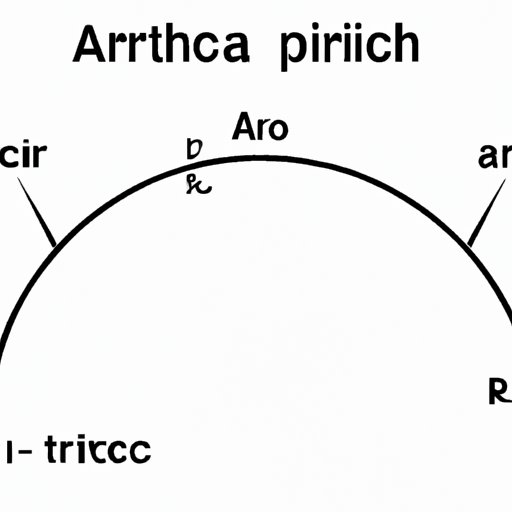
I. Introduction
As one of the fundamental concepts in geometry, arc length can pose a significant challenge for those unfamiliar with its principles. However, with the right guidance and understanding, finding the arc length of a circle can be an achievable task. The purpose of this article is to provide a comprehensive guide to understanding and finding arc length, covering basic definitions, formulas, and real-life applications.
II. Mastering the Basics: Understanding Arc Length of a Circle
Arc length refers to the distance along a portion of the circumference of a circle. It can also be defined as the fraction of the circumference of the circle corresponding to a particular central angle. The relationship between arc length, angle, and radius of a circle is crucial to finding the arc length of a circle accurately. Examples of arc length in everyday life include measuring angles for constructing buildings, designing car wheels, creating circular logos, and so on.
III. Step-by-Step Guide to Finding Arc Length: Easy as Pi!
The standard formula for finding arc length is L = rθ, where “L” represents arc length, “r” denotes the radius of the circle, and “θ” stands for the central angle in radians. To use this formula, follow these steps:
- Convert the angle from degrees to radians using the formula radians = (π / 180) x degrees
- Multiply the radius by the angle in radians
For example, let’s say you have a circle with a radius of 5 inches, and you want to find the arc length of an angle of 90 degrees:
- Convert 90 degrees to radians: (π / 180) x 90 = π/2
- Multiply the radius by the angle in radians: 5 x π/2 = 7.85 inches (rounded to two decimal places)
Therefore, the arc length for an angle of 90 degrees in this circle is approximately 7.85 inches.
Practice problems are an excellent way for readers to apply the formula and solidify their understanding of the concept. Here is an example practice problem:
If a circle has a radius of 10 meters, what is the arc length for an angle of 45 degrees?
- Convert 45 degrees to radians: (π / 180) x 45 = π/4
- Multiply the radius by the angle in radians: 10 x π/4 = 7.85 meters (rounded to two decimal places)
Therefore, the arc length for an angle of 45 degrees in this circle is approximately 7.85 meters.
IV. Geometry Made Simple: How to Calculate the Arc Length of a Circle
While the basic formula can be used for most scenarios, there are specific issues that may arise when finding the arc length of a circle. The most common problem is correctly identifying the angle measurement and converting it to radians. It is also crucial to understand and use the correct units of measurements such as degrees, radians, centimeters, inches, and meters when solving the problem. To make it easier to understand, diagrams and illustrations can be used.
V. Visualizing Arc Length: Exploring the Relationship Between Pi and Circles
Pi (π) is a mathematical constant that represents the ratio of the circumference of any circle to its diameter, and we can use pi to find the arc length of a particular portion of a circle. Pi is an essential element in geometry, number theory, and trigonometry and is typically approximated to 3.14 or shortened to 22/7. It had been discovered by the mathematician Archimedes in ancient Greece. To help with visualization, it is useful to have examples of how pi relates to circles, such as the construction of gears and wheels.
VI. Mathematics for Beginners: A Comprehensive Guide to Arc Length
To beginners in mathematics, finding the arc length of a circle can seem like an overwhelming task. To break it down further, understanding and mastering the basic mathematical skills applicable to arc length is crucial. Breaking down the formula into its individual components is also helpful. The formula ‘L = rθ’ can be divided into ‘L,’ which stands for the arc length, ‘r,’ which represents the radius, and ‘θ,’ which represents the angle measure in radians. Understanding these concepts will help in calculating the arc length of the circle with ease.
VII. From Theory to Practice: Applying the Arc Length Formula in Real-Life Scenarios
While it is easy to imagine arc length as an abstract concept, it has a wide range of real-world applications. For example, in the design and construction process, architects and engineers often use arc length measurements to make accurate and consistent cuts and designs. Understanding arc length can also be crucial for trigonometry calculations or general distance calculations in geography.
VIII. Conclusion
In conclusion, finding the arc length of a circle can seem challenging at first glance. However, understanding the basic principles and applying the formula correctly can make the process much more manageable. Remember to take note carefully of all the concepts discussed in this article and make use of practice problems until the concept becomes second nature. With this knowledge, you can apply arc length in real-life scenarios to solve problems that require distance calculations around circles with ease.





